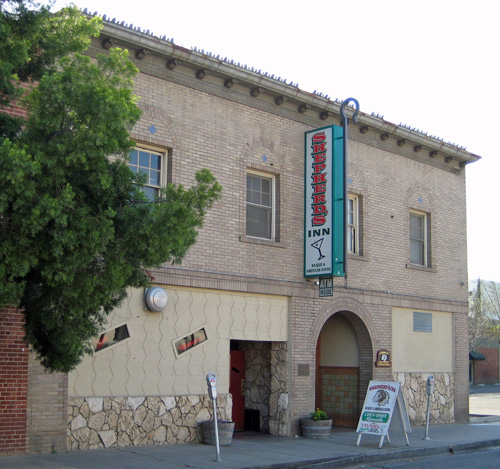
Santa Fe Hotel (1926)
935 Santa Fe Avenue
Telesfuro Jance,
Builder
Period Revival
Description
The Santa Fe Hotel is a two-story brick structure with a sheet metal ornamental cornice. It features an off-center entrance through a round arch opening. The original glass openings on the first-floor street frontage have been in-filled with stucco and applied stone wainscot. An off-center round arched opening adds interest to an otherwise bland treatment of a modified Renaissance Revival front facade. The front entrance has hand-made multicolored tiles on both sides of the entry. Single blue tiles above the windows appear to be the mark of the architect.
The first floor consists of a bar and a large dining room where boarders could eat together at large tables. The second floor includes a combination of private rooms and small dormitories.
Historical significance
The Santa Fe Hotel is one of the oldest and most important Basque institutions in Fresno. Historically, Basque hotels constituted a network of ethnic establishments through which Basque immigrants could enter and move about the United States with a maximum of protection and a minimum of culture shock. As was the custom, the Santa Fe Hotel was built near the railroad station.
For its old-world clientele, the Santa Fe Hotel was both a way station for the newly-arrived immigrant and a haven for the unemployed. The hotel also was the base of operations for the Basque sheepmen in town on business. Since it first opened, it has helped its clients earn their living, providing local employment information. Sheep ranchers in need of herders usually began their search at the hotel.
The hotel served the nomadic Basque sheepherder and itinerant operator as the closest thing he had to a "home." It was his mailing address, and the hotelkeeper would save his letters for many months, if necessary. It was the place where he left his good town clothing when out on the range, and his bedroll and rifle when in town. A special room stored such items. In this storeroom there have been as many as one hundred bedrolls at a time, even though some of their owners had not been heard from in over twenty years.
For the man who was either injured or ill, the hotel served as a clinic where he could recuperate. In the early years, it was common for Basque women living on isolated ranches to board in the hotel during the later stages of pregnancy. The baby often was born in the hotel, and the hoteleeper's wife frequently served as midwife. Basque children living on isolated ranches might be boarded at the hotel during the school year. The hotel also functioned as a home for the elderly, with a population of retired bachelor herders who preferred to live out their lives in the United States rather than return to the old country. Sometimes the hotel functioned as a funeral parlor, where a corpse spent its last night before interment.
A secret of the Santa Fe Hotel's success was the proprietor's ability to be a confidant in his clients' financial affairs, legal matters and general dealings with the Anglo world. The Basque sheepherder generally had a limited education, and the isolation inherent in his occupation prevented him from learning the English needed to understand American society. Thus, he was sorely unprepared to deal with the local banker, lawyer or doctor. In all of these areas, the hotelkeeper could be counted on to serve the herder both as interpreter and protector of his interests.
The Santa Fe Hotel also gave Basque-Americans some semblance of ethnic tradition. Entering the hotel they found an ethnic context in which they were regarded as holding at least some credentials. Over the years both local and out-of-town Basque-Americans have constituted an important segment of the hotel's clientele. While most successful Basque-American travelers are reluctant to actually stay overnight in the hotel's simple lodgings, they are likely to be found there at the dinner hour.
In recent years the Santa Fe Hotel has acquired a considerable non-Basque tourist trade. Although the hotel advertises little, there are many devotees of the Basque cuisine and atmosphere who make a point of frequenting the Santa Fe. Part of the attraction lies in the hearty, ample and inexpensive fare, and the camaraderie of eating meals "family style" at a long boarding house table in the company of strangers. Of particular delight to tourists is the old world atmosphere of the bar, where questions concerning the "mystery" of the Basques may be directed to the bartender.
Adapted from the National Register of Historic Places nomination, originally prepared by Wanda Lespade.